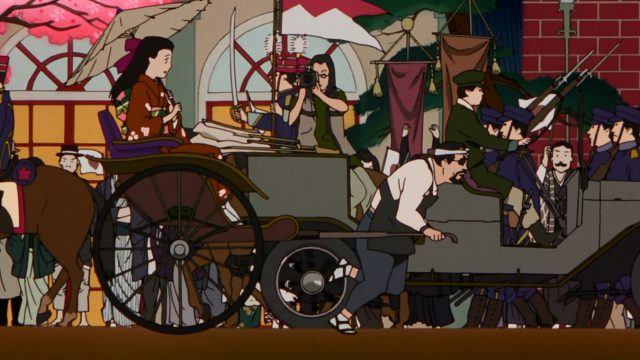Satoshi Kon left us on August 24, 2010; and he left the cinema world with its boldest, most delirious and disorienting montage. He seemed to reinvent the very conception of an edit with every film, first in Perfect Blue, with our point of view always traveling through dreams and diegeses and photos and points of view, using its constantly in-motion structure as its ultimate expression of horror. You can trust nothing when your point of view is constantly changing. After that film, Kon set to work on Millenium Actress, using the same style for an opposite goal: a comforting, emotional story, which blends the onscreen and offscreen realities
From the opening scene, the “countdown” to launch, Kon uses two very quick shots, each less than a second long, to make us question our reality: first, an audience member sitting, watching the film within the film, to let us know that what we have just been seeing is false, and the second, as Kon cuts to his face as they count down to “two”, just before cutting back to Chiyoko in perfect rhythm as the voice counts “one.” With this second cut to the man, Kon has asserted that his montage is supreme, and put the two distinct worlds back together as soon as he’s pulled them apart. Was that cutting, a different shot on “five, four, three, two” and “one” part of Kon’s film or the film within the film? Both? It’s decidedly more complicated than the old trick of cutting to the audience to let the viewer know that we’ve been watching a film within a film this whole time; that one goes back to Sullivan’s Travels in 1941, and Kon had already used it in Perfect Blue). Here, he is refining his touch and doing something more methodical, and more mature.
We start at the end of Chiyoko’s life, getting voiceover from our documentary POV characters telling us that the studio that made Chiyoko famous is now being demolished after seventy years. After hiking up to her house, far away from the town below, they finally sit down to do their interview. There is a lingering shot of many magazines scattered, overlapping on top of each other on the floor, with Chiyoko’s face repeating and repeating. That shot mirrors the structure of what we’re about to watch: many fictional moments overlapping and overlapping that reveal the truth about Chiyoko’s life.
The cameramen for the documentary are indeed our POV characters, or so we think: they’re literally transported into Chiyoko’s memories, and they film what they see. This, perhaps, is a metaphor for them getting wrapped up in the story of Chiyoko’s life, but perhaps it’s entirely literal: they’ve been spatially transported into another world, and they film young Chiyoko while old Chiyoko narrates. Are we watching the film that they’re filming? We can’t be sure that any of the shots we get in this second world are coming from their camera. Maybe, but maybe not.
I’m always fascinated by the way this film is able to move from melancholy memory to delirious, triumphant celebration of nostalgia without skipping a beat. Kon is constantly in motion, not just in the edit but in his “camera”. There is one sequence in the middle where Chiyoko is rushing to the right, and she morphs from a samurai on a horse to an aristocrat on a horse and carriage to a Japanese princess being pulled on a rickshaw and finally to a young girl on a bike, where suddenly, the motion stops and we’re right back to a memory: she was once a young girl on a bike, who met with a young man, a revolutionary and painter who she never found again.
Mementos and nostalgia circle the film. Though we can’t always be sure where we are, we are sure of this memory that Chiyoko has about this painter that she never again found. The entire film, and perhaps Chiyoko’s entire life, plays like a long, roundabout search for him. Chiyoko’s rationalization, that he would finally see her in one of the films and know where to find her, confirms this. That memory, so striking in its simple emotion, is the heart of the film’s story about loss and regret. For Chiyoko, a filmography is a biography, and these movies were her tool to find her love, a love that consumed her.
Yet this is not a sad movie: it’s full of delirious comedy and life-affirming freedom. Chiyoko’s life was fantastic and hearing about it, you can’t help but take part in that fantasy like the cameramen who get stuck there. Speaking of those cameramen, they’re our comic relief as well as our POV: recall that rickshaw that she was pulled on in that montage of motion, one of our documentarians was struggling to pull her along, while the other was riding on her side in the carriage, filming her. Throughout her films and her life, the same characters popped up again and again and again.
Does all this slippery montage and shifting space signify an unreliable narrator? Perhaps Chiyoko is not quite serious about her life? I believe that the purpose of all the intercutting, the disorientation, is to use the films-within-the-films as a metaphorical tool. Chiyoko sometimes felt as poised as a princess on a carriage, as free as an astronaut, and yet sometimes as small and insignificant as the main character of a kaiju film or like she was trapped by arrows shot at her by samurai. All films are the stories of life. Every filmic image has life inside it, the life of everyone who made it and everyone who watched it. This film has a bit more life than most, because Chiyoko is a good storyteller, and so is Kon.
Back to that opening scene, where after the men leave the room where they’ve been watching the sci-fi film, they rewind the tape and the tape rewinds backwards not just in that sci-fi film, but for many moments in Chiyoko’s life that we will end up seeing. Is this the film rewinding? Is this the film within the film rewinding? Are they watching Millenium Actress? The ending, which returns to this image, only complicates matters further, but none of the film’s diegetic shenanigans detract from its power. Kon’s montage disorients poetically: he is always complicating and questioning the relationship of our lives to the movies. In North America this would be called “meta,” but there’s nothing else quite like it. The closest reference point I can think of to Kon’s work on this film is Adaptation, but there is nothing so orderly as that film’s final revelation in Millenium Actress. Though his inspirations are numerous, Kon is in a league with only himself.


